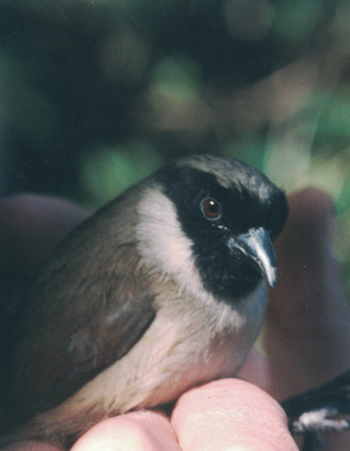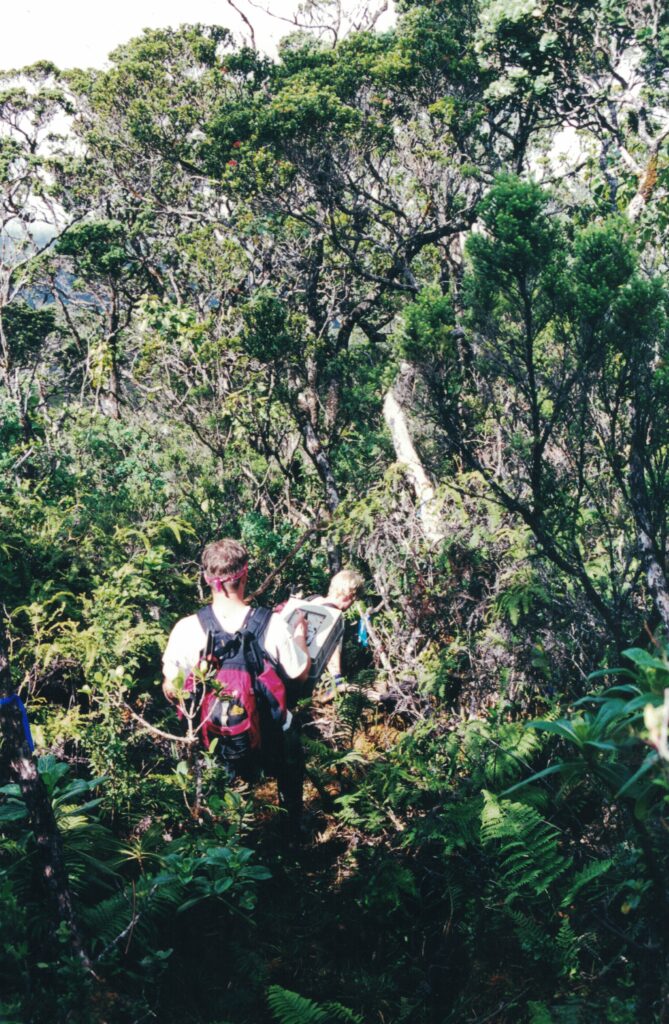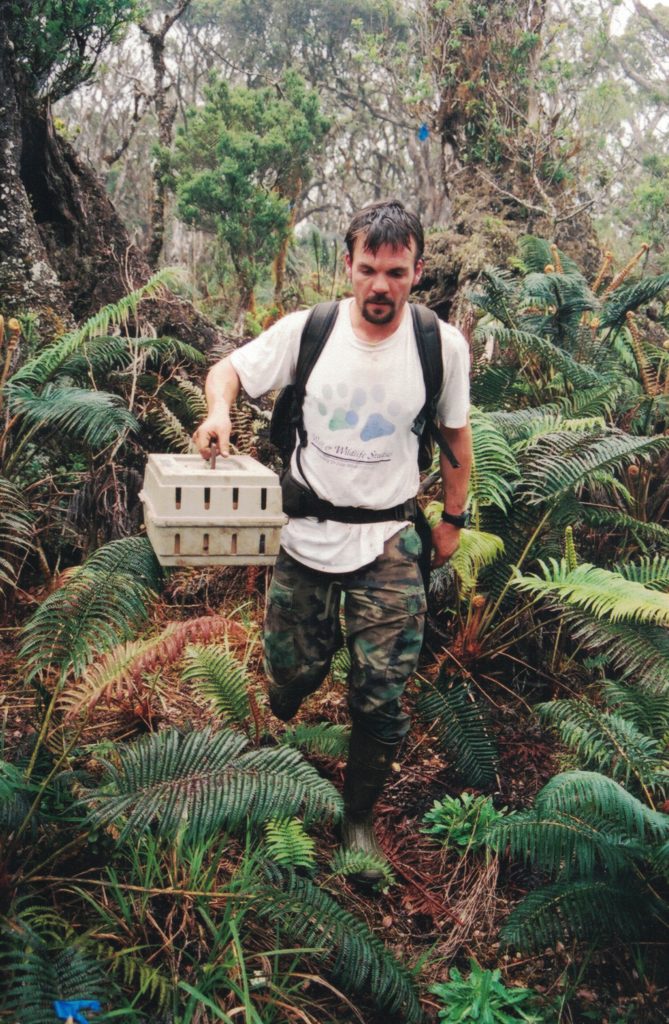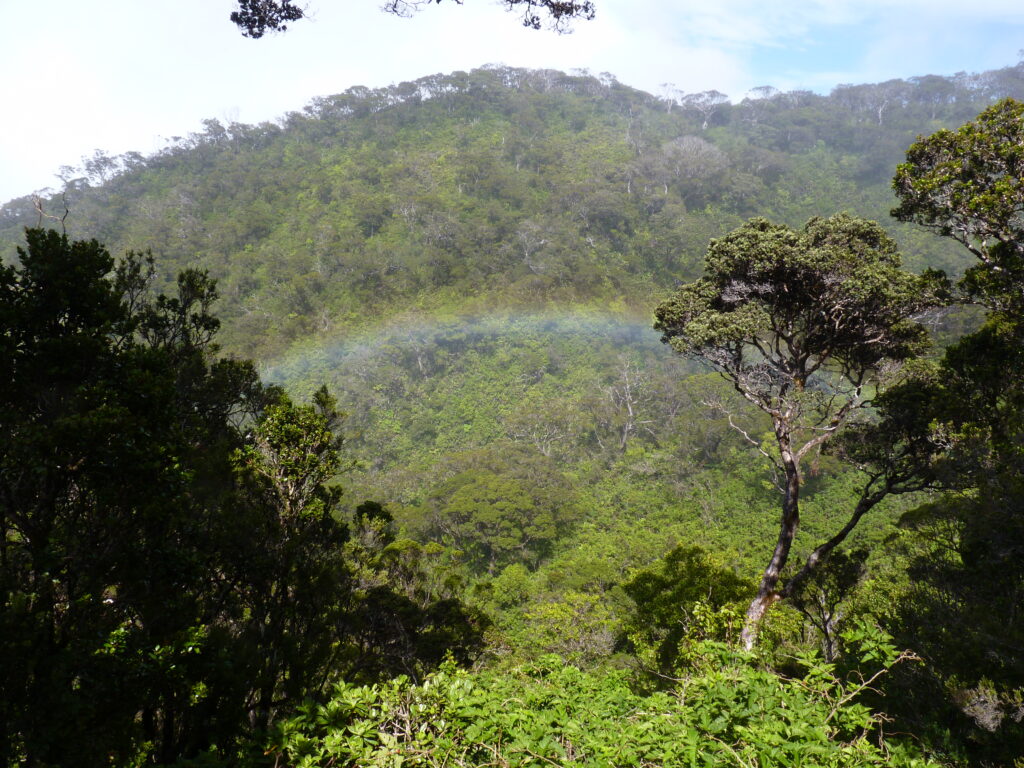What’s at Stake: The Story of the Poʻouli
OUR MOST RECENT EXTINCTIONA Legacy of Loss — and Hope
Hawai‘i is home to one of the most spectacular radiations of bird life in the world. Isolated in the middle of the Pacific, its forests once echoed with the songs of dozens of honeycreeper species found nowhere else on Earth. Over 54 different species of Hawaiian honeycreepers (or finches) once existed. But since human arrival and the introduction of invasive species, about ⅔ of Hawai‘i’s native finch species have gone extinct. Only 17 species remain and many are threatened with extinction.
Recent Extinctions
Sadly, extinction is not just a thing of the past. In 2023, the U.S. Fish and Wildlife Service officially declared the extinction of:
- Maui ʻAkepa (Loxops ochraceus)
- Maui Nukupuʻu (Hemignathus affinis)
- Poʻouli (Melamprosops phaeosoma)
These species join a growing list that includes the ʻŌʻū, Bishop’s ʻŌʻō, Maui-nui ʻAkialoa, and the Maui ʻOlomaʻo.
See Eight Hawaiian Bird Species to be Declared Officially Extinct.
Remembering the Poʻouli
The Poʻouli, or “black-faced” honeycreeper, was one of the last bird species discovered in Hawai‘i—and one of the first to inspire our work.
Discovery and Decline
In 1973, researchers from the University of Hawaiʻi made a startling discovery in the remote rainforests of East Maui: a new bird species, unknown to collectors or Hawaiian oral tradition. The Poʻouli belonged to a unique, monotypic genus and lived only in the wet forests of Haleakalā.
In 1980, surveys estimated a population of 140, though actual observations were sparse. By 1994, fewer than 10 individuals remained. By 1997, only three Poʻouli were known to exist—each in a separate territory.
Poʻouli were especially vulnerable because of their unusual diet, relying primarily on native land snails. Combined with habitat loss and damage from feral pigs, their numbers continued to plummet.
Conservation Efforts
In 1986, the Hanawī Natural Area Reserve was established to protect native forest birds like the Poʻouli. Fencing and pig removal began in the early 1990s, and in 1994, a “rare bird search” confirmed just three Poʻouli were left.
Between 1997 and 1998, all three birds were captured and banded to help monitor them. In hopes of breeding the last individuals, DNA samples were analyzed to determine sex—but results were inconclusive.
There was hope: at least one male and one female were believed to remain but they were located in separate territories.
It was decided that the safest way to bring the male and female together to reproduce was to translocate one of the females across the mountain into the territory of the male. Trial runs with Maui ‘Alauahio, a more abundant honeycreeper species, were performed in 2001, to determine the best method of transport.
After this, in 2002, biologists launched an ambitious effort to bring the birds together. A female Poʻouli was translocated across the mountain into the male’s territory. She was fitted with a radio transmitter and released near his known roosting site. Unfortunately, by the next morning, she was slowly making her way back to her original home range. A pair did not form.
With options running out, the decision was made in 2002 to bring all three birds into captive care at the Maui Bird Conservation Center. In September 2004, the male Poʻouli was captured and brought into the facility. He was elderly and partially blind. Despite dedicated care, he died in November 2004. The other two Poʻouli were never seen again.
In 2023, after nearly 20 years of no sightings, the U.S. Fish & Wildlife Service officially declared the Po’ouli extinct.
Why It Matters
The extinction of the Poʻouli was a heartbreaking loss—but also a turning point. The concern over the plight of the Po’ouli led to the founding of our organization and the start of decades of effort to ensure no more Hawaiian birds are lost forever.
The Poʻouli may be gone, but its legacy inspires everything we do. We cannot wait to act to protect these species or we risk extinction and the loss of these jewels of the forest and keystone parts of the Hawaiian ecosystem and culture.
Through science, partnerships, community involvement, and deep respect for Hawaiian ecosystems, we fight to protect the Kiwikiu, ʻĀkohekohe, and other forest birds still clinging to survival.
The Hawaiian forest birds face continued decline due to habitat loss and degradation, Introduced predators and ungulates, and avian diseases, like malaria and pox. Because these diseases are spread by mosquitoes, native birds are now restricted to high-elevation forests, where cool temperatures slow mosquito survival. Our team combines habitat restoration with scientific research to reverse this trend and bring endangered birds back from the brink.
Learn More
- Explore our Research and Conservation work.
- Support our mission.

Image by Doug Pratt





Recommended Reading
For further information on the Po’ouli story, consider reading:
- Powell, Alvin. 2008. The Race to Save the World’s Rarest Bird: The Discovery and Death of the Po’ouli. Mechanicsburg, PA: Stackpole Books.
- Walther, Michael. 2016. Extinct Birds of Hawai’i. Mutual Publishing, LLC.
- Baker, P.E. 2001. Status and distribution of the Po’ouli in the Hanawi Natural Area Reserve between December 1995 and June 1997. Studies in Avian Biology 22:144-150.
- Baldwin , P.H. and T.L.C. Casey. 1983. A preliminary list of foods of the Po’ouli. ‘Elepaio 43:53-56.
- Casey, T.L.C. and J.D. Jacobi. 1974. A new genus and species of bird from the Island of Maui, Hawai’i (Passeriformes: Drepanididae). Occasional Papers Bernice P. Bishop Museum 24:216-226.
- Engilis, A., Jr. 1990. Field notes on native forest birds in the Hanawi Natural Area Reserve, Maui. ‘Elepaio 50:67-72.
- James, H.F. and S.L. Olsen. 1991. Descriptions of 32 new species of birds from the Hawaiian Islands: Part II. Passeriformes. Ornithol. Monogr. 46:1-88.
- Kepler, C.B., T.K. Pratt, A.M. Ecton, A. Engilis, Jr., and K.M. Fluetsch. 1996. Nesting behavior of the Po’ouli. Wilson Bulletin 108:620-638.
- Mountainspring, S., T.L.C. Casey, C.B. Kepler, and J.M. Scott. 1990. Ecology, behavior, and conservation of the Po’ouli (Melamprosops phaeosoma). Wilson Bulletin 102: 109-122.
- Olsen, S.L. and H.F. James. 1991. Descriptions of 32 new species of birds from the Hawaiian Islands: Part I. Non-Passeriformes. Ornithol. Monogr. 45:1-88.
- Reynolds, M.H. and T.J. Snetsinger. 2001. The Hawaii Rare Bird Search 1994-1996. Studies in Avian Biology 22:133-143.
- Scott, J.M., S.Mountainspring, F.L. Ramsey, and C.B. Kepler. 1986. Forest bird communities of the Hawaiian Islands: their dynamics, ecology, and conservation. Studies in Avian Biology 9.
Save the Forest, Save the Birds
It takes a community of dedicated individuals and support to make conservation happen
